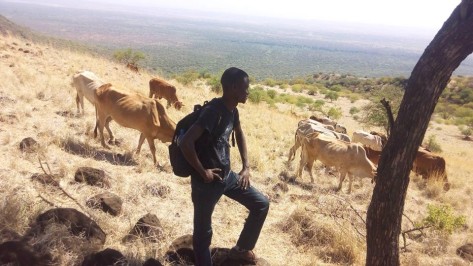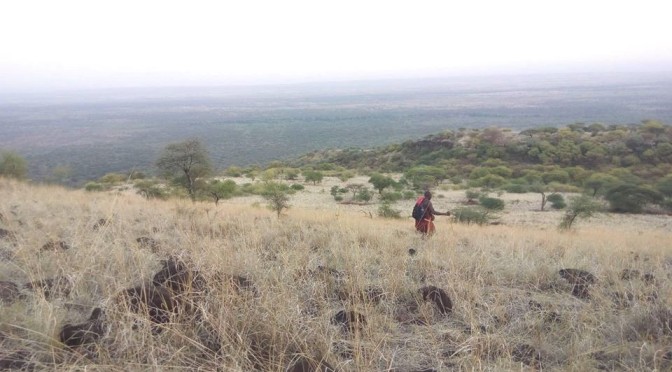As the drought in Southern Kenya intensifies the pastoral communities of the Magadi area fall back on their traditional drought grazing refuges. In a previous post we mentioned the importance of the Shompole swamp, in this post we cover settlement mapping of new homes atop the escarpment, where people are searching for pasture to keep their livestock alive. This report is from Joel Meja Sumare, an ecological Resource Assessor:
On Thursday 12th Jan 2017, early in the morning, the ecological team decided to follow the movement of livestock to the top of the hill, since people have already moved there because of drought, in a desperate search for pasture. The team decide to use their motorbikes for their work to the top of the hill, and two team members Joel Meja Somare and Peter Tajeu went there for new boma mapping, with the aim to map the new settlement and have a general idea of the area.
The journey took us three days to complete the boma mapping. We woke up early in the morning and we drove our motorbikes from Lale’enok to Lentorre Lodge, where we left our motorbike and used climb up the hill by foot to Tekeni and Engare kiti areas.

That day we visited Tekeni area where we found 2 bomas, with one boma occupied by 3 families and had only cattle, no shoats. The second boma was occupied by 2 families and has both shoats and cattle. We then we proceeded to Eng’are kiti to the next boma there. It was very far from the rest of the bomas at Tekeni. We walk through a thick bush area with a lot of buffalos and elephant’s tracks. It took over 2 hours to walk. We found one boma occupied by 4 families with both shoats and cattle. We spend the next two hours in a brief meeting with the owners to explain our normal work. After there went the next boma still at Engare kiti the furthest boma which is very far from the others. We mapped that boma and it was occupied by one family only and has both shoats and cattle. We decided to go back to where we left our motorbike so that in the morning we could wake up early and travel to Olodo-enteriti. At 7:16pm we arrived at lentore lodge where we slept, and we woke up the next morning at 6:00am. We manage to get to our destination at 2pm, the road was very rough and has many stones, which slowed our progress. We mapped the 3 bomas and we slept there. In the morning, we held a meeting with the community who are living there to discuss our normal work and they were very happy for us for have extending our work to their area.

The people from Olodo-enterit are having a serious problem Tsetse fly and request for traps to control or reduce the tsefly in that area. We came back at Lale’enok on Saturday night very tired but we thank God we arrived safely.
At all areas people were kind and cooperative.
Some of challenges we came across are:
- 1.Too hot
- 2.Long distances walking
- Stony and bushy
- Infested with buffaloes & elephants
- Tsese fly
- Ticks

